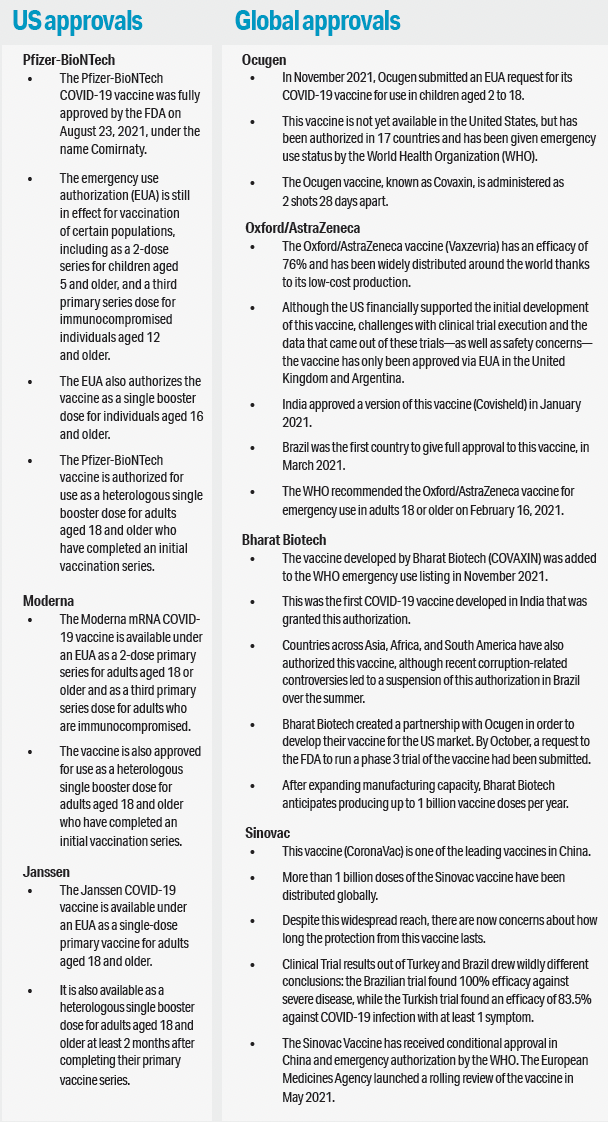Pharmacists Central to Distributing Pediatric COVID-19 Vaccines
As trusted source of information for parents, pharmacists are a key part of the plan to distribute the COVID-19 vaccine to newly eligible children.
Parents around the country breathed a sigh of relief late last October when the FDA issued an emergency use authorization for the Pfizer-BioNTech mRNA vaccine for children aged 5 to 11 years.1 Pharmacies, along with pediatricians’ offices and schools, have been identified as a major distribution point to administer the vaccines in children.
A Plan for Widespread Distribution
Prior to the FDA ruling, the White House announced that “tens of thousands of pharmacies across the country will offer the vaccine to their local communities.”1
“Pharmacists are a trusted source of information for parents, and local pharmacies will be a convenient, accessible option for many families. Pharmacies will o.er family-friendly in-store clinics to best meet the needs of local communities,” according to a statement from the White House.2
“Pharmacy partners will launch comprehensive campaigns to reach parents and families, including texts, calls, and outreach to meet local communities where they are.”2 The US government has purchased 50 million more doses of the Pfizer-BioNTech COVID-19 vaccine to prepare for the pediatric vaccine rollout, the companies said in a news release.3
“These important planning actions by the federal government will help ensure that pharmacies—the most accessible health care destinations in the country—are ready to continue to meet the needs of the American public when the time comes and when the science confirms that COVID vaccines for that age group are safe and effective,” said National Association of Chain Drug Stores (NACDS) President and CEO Steven C. Anderson in a statement.4
“Pharmacies remain critical access points in the ongoing vaccination effort and, as the 2021-2022 flu season persists, pharmacies continue to meet the nation’s preventive care vaccination needs, all in one visit,” he added.4
The Pharmacist’s Role
“The expectation is that pharmacists will play a major role in the administration of [children’s COVID-19] vaccines,” said Mitchel C. Rothholz, RPh, chief of governance and state affiliates at the American Pharmacists Association (APhA). Both chain and independent pharmacies are vital players within the national plan, he noted.
“Pharmacies within the federal COVID vaccination network (about 40,000 sites), as well as pharmacies that are part of their state/local jurisdiction plan, will have access to the Pfizer-BioNTech pediatric vaccine,” Rothholz said.
“Many of these pharmacies have been reviewing their operations and preparing for receipt and administration of the pediatric vaccines.” Pharmacists are also collaborating with their local school districts, Rothholz added. The vaccine is a 2-dose primary series, administered 3 weeks apart, at one-third of the dose—10 mcg—compared with the dose of 30 mcg for individuals 12 years and older.
How to Handle Children’s COVID-19 Vaccinations
“There is a lot being asked of vaccine providers across the health care system,” Rothholz said. Pharmacies are managing COVID-19 vaccines—including booster shots—along with seasonal influenza vaccines and numerous other immunizations. Some organizations are also providing staff to volunteer at COVID-19 vaccination clinics. As a result, Rothholz noted, it is “critical that both the public and private sectors devote the resources necessary to adequately and safely staff this enhanced campaign. The health of America depends on it.”
In addition, those who manage the pharmacy enterprise need to talk with their staff about how best to manage the workflow. “We are really encouraging that dialogue to happen so that workload can be talked through and supported where needed,” Rothholz pointed out. Managing the workflow will also help prevent pharmacist and pharmacy technician errors and reduce workplace stress. It will also reduce the likelihood of pharmacists and pharmacy technicians leaving the job or profession, Rothholz noted.
“Across the whole system—medicine, nursing, nursing assistants, [and] pharmacy team members—people are moving out of their professions and jobs. That is putting a strain on the system,” Rothholz said. “We are really trying to encourage discussions between management and their teams to talk through solutions.”
Many pharmacies are also utilizing appointment-based software systems to help manage the COVID-19 vaccine workload, according to Rothholz. The administration of the COVID-19 vaccine to children ages 5 through 11 is a collaborative e ort between the pharmacist and the parent or caregiver, who must work together to make the vaccine experience as nontraumatic as possible, Rothholz said.
Engaging the support of parents and caregivers in the process can help with managing the child’s concerns, Rothholz added. When possible, pharmacists
should avoid showing the needle to the child prior to vaccination. Parents can also be encouraged to bring iPads or other electronic devices to help with distraction. As always, pharmacists should confirm the vaccine the child is receiving with the parent or caregiver, Rothholz advised.

